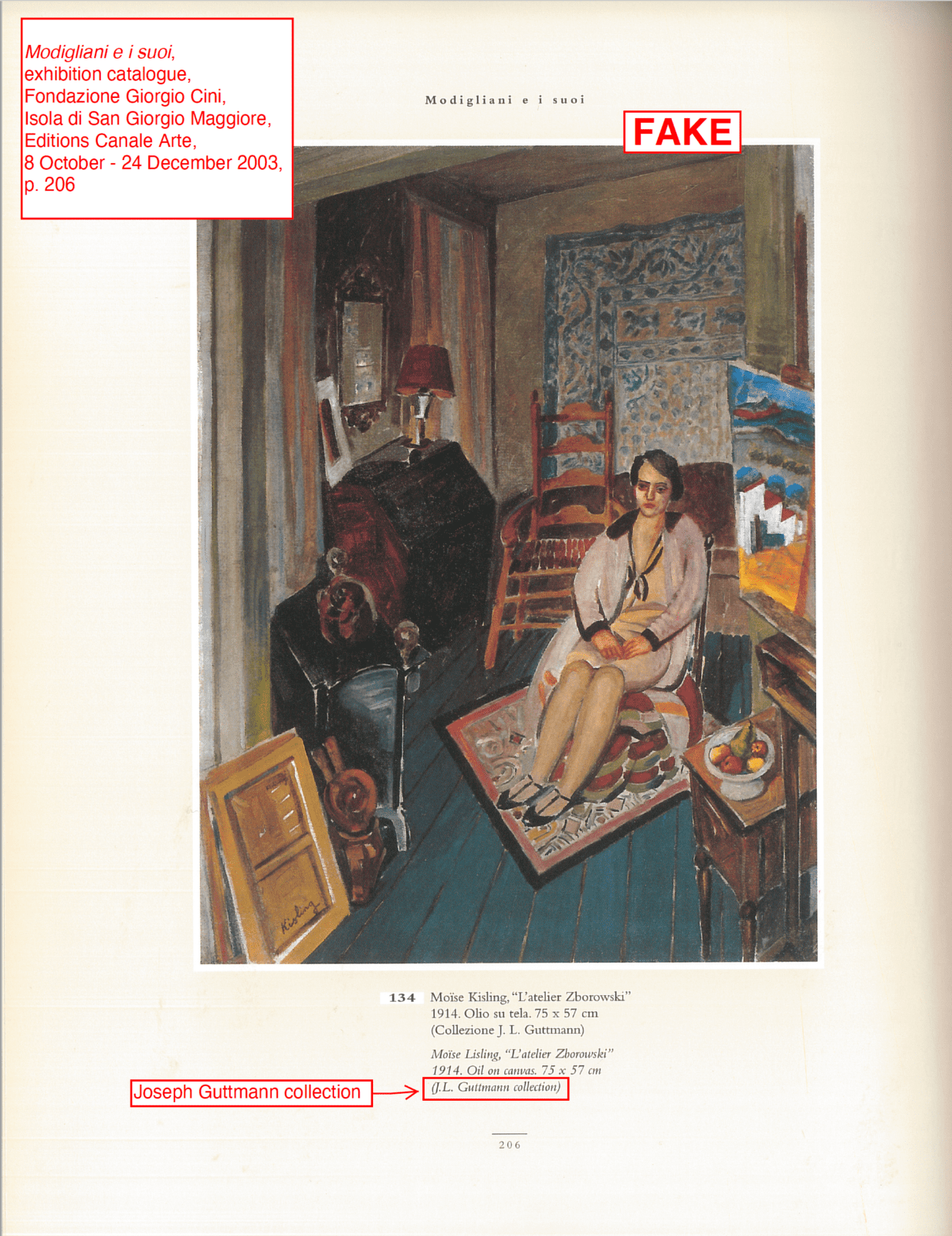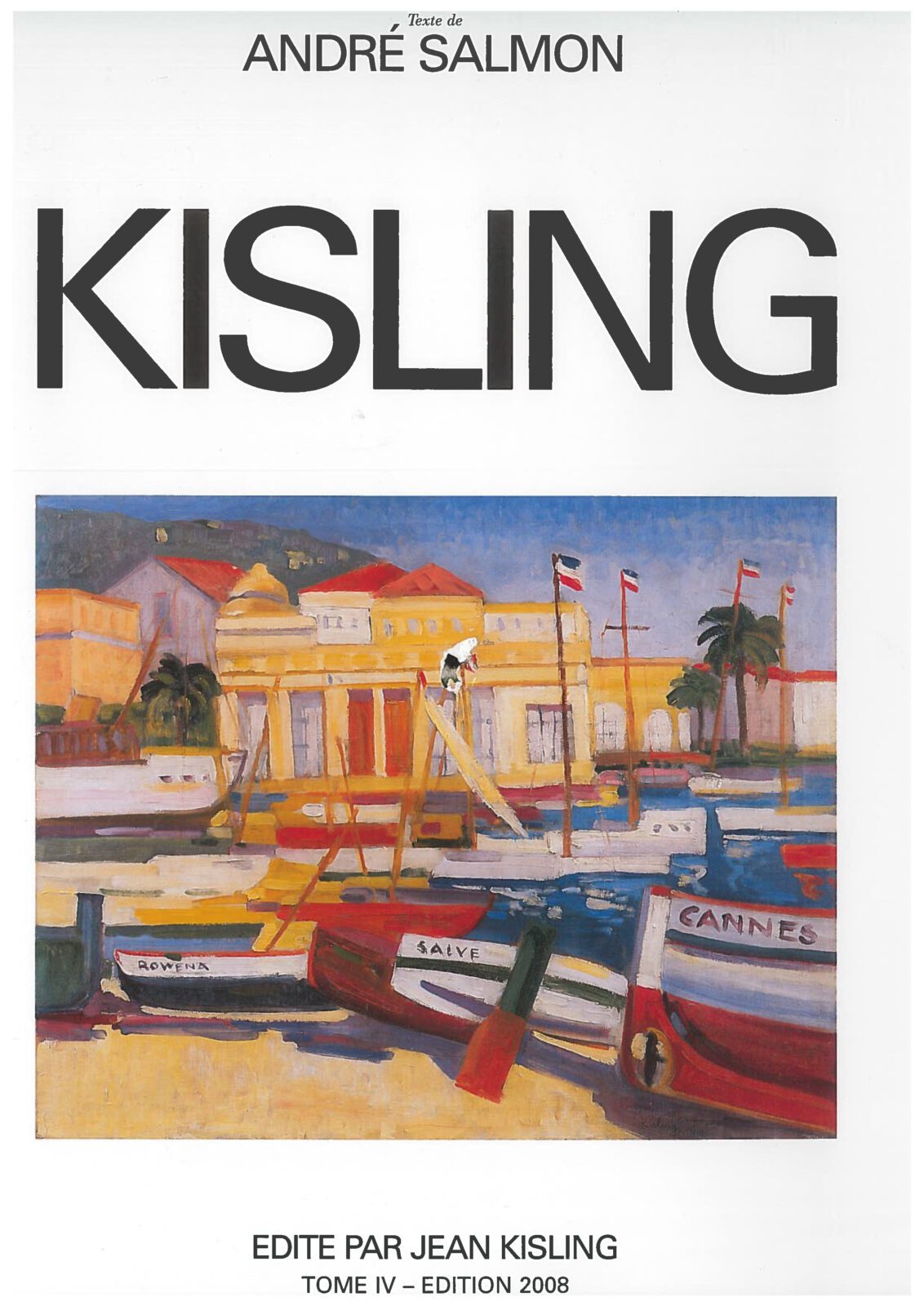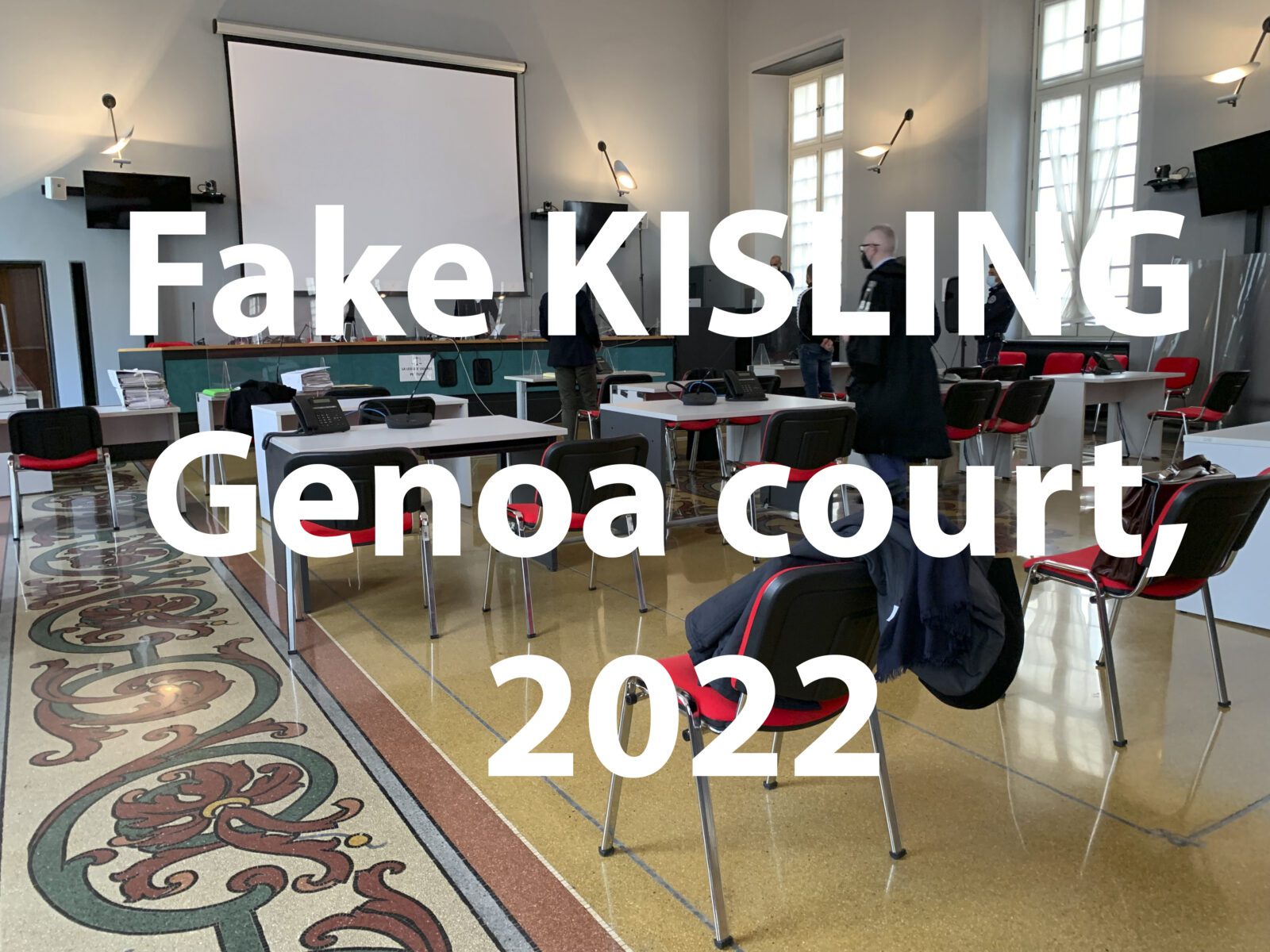In 2017, the Modigliani exhibition at the Palazzo Ducale in Genoa was closed on suspicion of forgeries.
Twenty-one pieces of art out of the 59 exhibited were seized by court order.
The trial was not relocated and is now being held in the same city 5 years later.
I was called in as a witness for 3 forged paintings bearing a « Modigliani-Kisling » signature, and 3 other forgeries bearing a Kisling signature.

Convocation Tribunal de Gênes
A fragmented trial
Since 2021, the hearing of the opposing parties, stakeholders and defendants has been going on for more than a year, at the rate of one court hearing per month. These jumps in time do not facilitate the follow-up and understanding of this complex case by the Court.
On the morning of February 24, I went to court, which is located in the historic old town of Genoa. At the address indicated on the summons, there is a massive building with facades cemented without any taste or grace, a clumsy renovation of a seventeenth-century building, where only a few fragments of the period frescoes remain on the ceilings.
Prior to this hearing, I had sent the court a list of inconsistencies in the provenance, dating and inaccurate statements in the catalog of the Palazzo Ducale (VISIT : Fake Kisling – Court hearing in Genoa, 2022).
After the study of a common law offence, Judge Deplano opened the Modigliani-Kisling hearing at 10 am.
Of average height, blunt, and with a sharp tone of voice, Mr. Deplano is authoritative and his attitude is more like that of a prosecutor than a judge.
However, this authoritarianism is aimed more at giving importance to the lack of depth of his questions ,than at getting to the heart of the matter.

Fondazione Giorgio Cini, 2003
The judge asks his 1st question in a hurried tone, in order to impose his own pace:
« How do you know that these paintings come from Mr. Joseph Guttmann?
There are 6 paintings in the Genoa exhibition, numbers 34/37/38/39/40/41 in the exhibition catalog.
As soon as I said that, in a previous exhibition at the Fondazione Giorgio Cini, no. 34 (SEE DOCUMENT ON THE LEFT) had been presented in 2003 as belonging to the Guttmann collection, I was interrupted by another question.
I was not allowed to explain that these 6 paintings come from the same forger, and that through this lineage, the connection can be traced back to the commissioner, Mr. Joseph Guttmann.
As the questions went on, I realized the court had decided not to mention tangible pieces of evidence that exist nonetheless: erroneous dates, false provenances, misleading bibliographies and exhibitions, made-up references… and did not want to exploit any of these inconsistencies.
The questions are of a « cosmetic » nature: « Do you know that these paintings have appeared in exhibitions before? » or of a factual nature: « Who attended the expert meetings? », « Who signed such and such letters? » without ever getting to the heart of the matter: genuine provenances, dummy-companies/nominees, insurance value, distribution network…
Cutting all of my answers short with his questions, Judge Deplano intends to lead the proceedings. However, his oratory art consists in avoiding the fact that I am stating incriminating evidence: a global distribution system imagined by Mr. Joseph Guttmann, where he assigns a role to each participant.
The originator reigns over the forger, the authentication, the provenance fabricator, the curator of the exhibition, the choice of the nominees, the bibliography magician and curators … at his service.
At the end of my hearing I offered the pseudo-Volume IV on Kisling published by Guttmann in 2008, to Judge Deplano, who was delighted with it.

Pseudo Tome IV sur Kisling édité par Guttmann en 2008
From the reproachful look on Guttmann’s lawyer’s face, I understoodd that the judge did not have in his possession any of the reference biographies necessary for a proper understanding of the case, and had only the catalog of the Palazzo Ducale as a basis of information.
From pointillism to surrealism
Several events marked the hearing:
- The expulsion of the co-worker who was accompanying me; who was not only ordered to leave the courtroom, but also made to stay in the antichamber under the guard of a carabiniere, who watched him even when he was visiting the restroom.
The expulsion by the judge of this single visitor resulted in a closed session, which is usually only seen in trials for indecency. - The confiscation of my documentation and the interdiction to use it
- The intimidation attempt that was addressed to me by the judge in French: « Be careful, it’s dangerous here
- The obligation to answer only yes or no to the questions asked by the judge, which prevented me from substantiating my answers.
« Are these disputed paintings duplicates? Si o no ».
I answered « no » for the Kisling because the subjects are made-up, but I didn’t have time to answer « yes » for the Modigliani, which was inspired by existing paintings (knowing that « duplicate » doesn’t have the same meaning in Italian as in French).
Prosecutor = defender of the interests of society
The judge, who had ordered the trial, gave the floor to the prosecutor, an affable man with a reassuring stoutness, bent over his notes, and whose most striking question was:
« When you were in front of the paintings, how did you know they were fake? »
It was hard for me not to mention as the only answer, the 20+ years I spent studying the work of Moses Kisling, which trained my eye.
I would have described a feeling, but not evidence, if I had evoked as an answer the heaviness of the brush strokes, the pasty rendering of the colors, the lack of differentiation of the planes… in short, the mediocrity of the forger in his plagiarism.
I waited in vain for the fundamental question: « On what tangible evidence do you base your claim that these paintings are fake? »
I could then have evoked the incoherence of the dating, the fabricated provenances, the falsified bibliographies…
Without a moment’s hesitation, the prosecutor gave the floor to Joseph Guttmann’s lawyer, the main defendant in this trial, but who was absent from the hearings.
Mr. Joseph Guttmann’s lawyer
Guttmann’s lawyer, about forty years old, had a closed expression on his face. He was accompanied by an assistant, whose expression and head nods visibly disapproved of every statement I made.
We were both situated on opposite sides of the room, about twenty meters apart. The lawyer crossed that distance with a disapproving lookon his face, to bring me some documents he deemed essential:
- A 2013 letter from Jean Kisling comforting Joseph Guttmann …
- An excerpt from a page taken from my website, in case I had forgotten it …
- A contract drafted with Jean over 15 years ago …
In fact, he only argued about the details:
– « Why did French television film the destruction of the Guttmann catalog by Jean Kisling? Who took the shots? Do you know that Canale printed the four volumes of Kisling? »
– « Do you know that these paintings were exhibited in 2015 in Seoul? »
– « Yes. »
– « But you did not file a complaint at that time? »
Judge: « Answer with if or no. »
« No. »
I regret not having taken a quick course in Korean, but especially not having been invited into the loop of museum exhibitions, of which one of the goals was to ensure legitimacy for the Guttmann production and its marketing.
Are the dice stacked and the game rigged in advance?
By only mentioning peripheral subjects, the questions from the judge, the prosecutor, Guttmann’s lawyers or the curator Chiappini never got to the heart of the matter: where do these paintings come from? what is their real background? and how could they be authenticated and sold?
The embarrassment of the court was palpable. Even when asked in a martial tone, the abundance of subsidiary questions indicated a desire not to take a position and to skirt the issue.
Out of these proceedings, which bring together Modigliani and Kisling, Art must emerge victorious, and the counterfeit paintings removed from the market.
Without such a courageous decision, Italy would obviously show a lack of interest toward one of its major artists from the XXth century.
Marc OTTAVI






